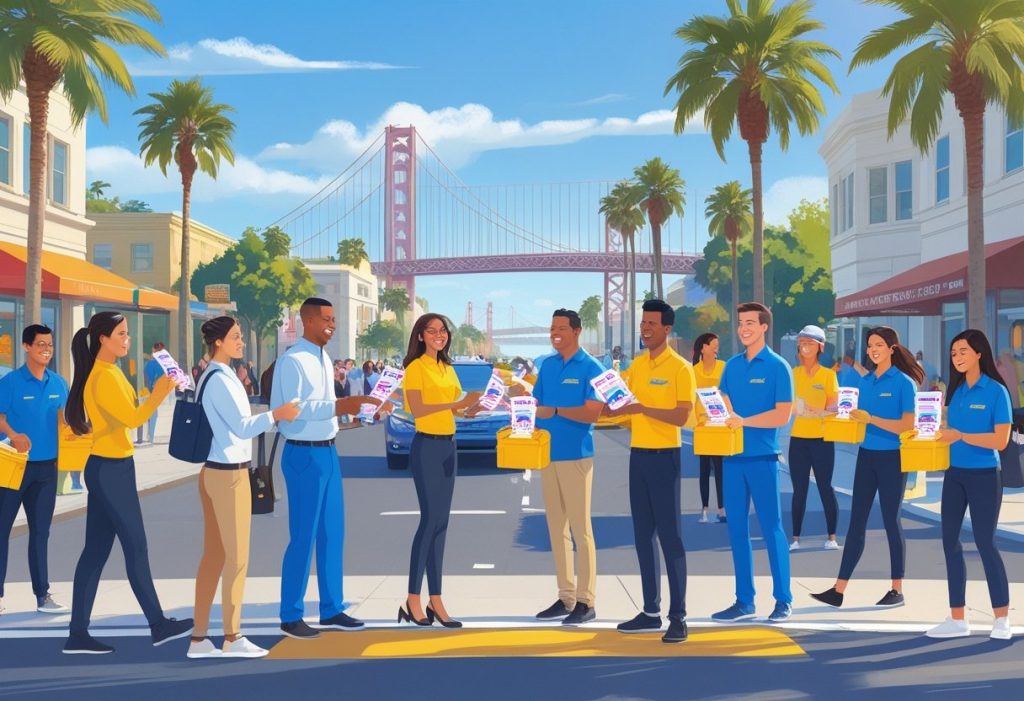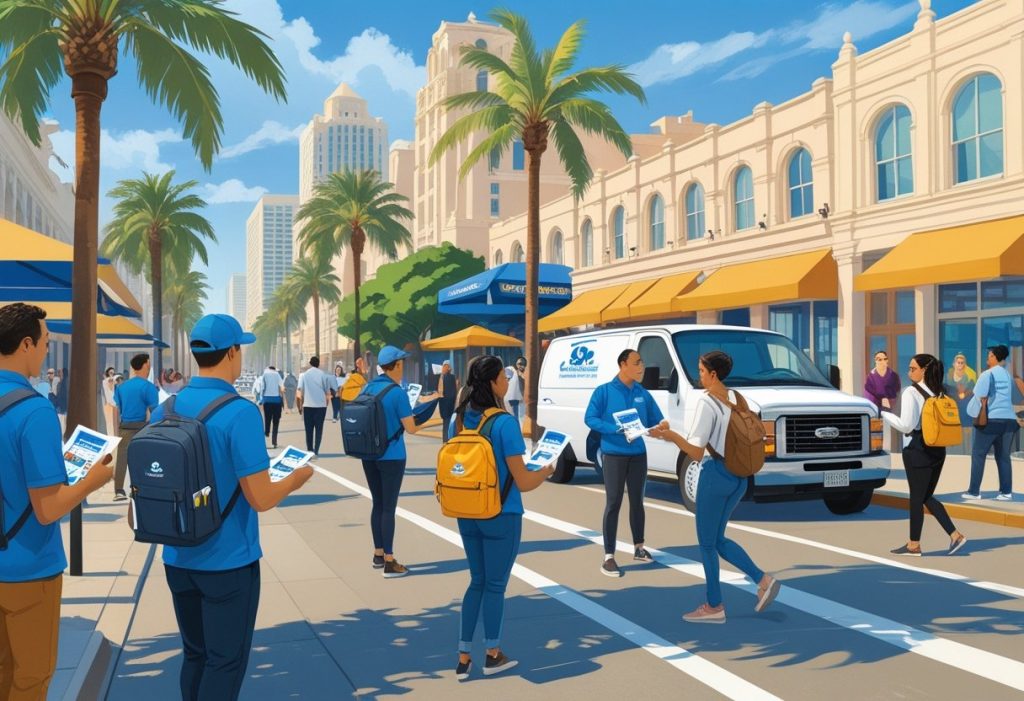Looking for a trustworthy flyer distribution service near San Diego? It’s one of the best ways for local businesses to connect with customers right in their own neighborhoods.
A reliable flyer distribution company makes it easy to reach people and share important information about products, services, or events.
Whether you’re just opening up shop or you’ve been around for years, flyers still work. They help boost awareness and bring more people through the door.

Flyer companies use a bunch of different ways to get your message out—door-to-door drops, handouts in busy spots, or targeting certain neighborhoods. Many of them even use tech now, so you can track results and plan smarter next time.
Picking the right service really comes down to knowing your goals and making sure the company’s approach matches what you need.
Key Takeaways
- Flyer distribution helps local businesses reach more people in San Diego.
- Services offer different delivery options and tracking tools.
- Picking the right provider depends on business goals and campaign needs.
What Is a Flyer Distribution Service Near San Diego?

A flyer distribution service near San Diego helps businesses reach local customers. They deliver printed flyers or door hangers straight to homes or businesses.
These companies use different distribution methods to target neighborhoods that fit what you’re looking for.
Definition and Purpose
A flyer distribution service is a company that brings physical marketing pieces—flyers, pamphlets, or door hangers—right to households or business buildings. The main idea? Help local businesses advertise products, events, or services.
Restaurants, gyms, cleaning services, and home improvement companies use flyers all the time. This kind of service lets businesses zero in on local customers who are most likely to care.
By picking certain neighborhoods or zip codes, companies can bump up their odds of getting new customers. Local flyer distribution services know San Diego inside out, from busy neighborhoods to business zones.
That local know-how makes sure flyers don’t end up in the wrong places.
Common Distribution Methods
Flyer distribution companies have a few main ways to get the word out:
- Door-to-Door Delivery: Distributors walk through neighborhoods and leave flyers on doors or in mailboxes.
- Door Hangers: A heavier piece is hung on the door handle, so it’s hard to miss.
- Hand-to-Hand Distribution: Staff hand flyers to people in busy spots like malls, parks, or outside events.
Lots of services use GPS tracking or phone check-ins to confirm the job got done. Some even offer mapping tools and targeting based on household types, demographics, or past campaign results.
Flyer vs. Door Hanger Marketing
Flyers and door hangers both show up in local marketing, but they’re not quite the same. Flyers are usually single sheets—easy to tuck in a mailbox, pin to a board, or hand out in person.
Door hangers are thicker, cut to fit door handles, and tough to overlook when you get home. They grab attention better than a loose flyer.
The choice really comes down to budget, your message, and how much visibility you want. Some businesses go with both, just to cover all their bases—mailboxes and door handles alike.
Benefits of Flyer Distribution for Local Businesses

Flyer distribution lets San Diego businesses connect right with their neighbors. Stores, restaurants, and service providers can reach new customers through targeted, cost-effective offline marketing.
Target Audience Engagement
You can hand out flyers in specific neighborhoods or give them straight to people who seem interested. Gyms might target shopping districts, while new restaurants often pass out flyers nearby.
Businesses decide where and when to distribute. That way, promotions or grand openings get noticed by the right crowd, not just anyone walking by.
Flyers are easy to read and can highlight deals or events clearly. When you hand them out at local events or parks, you boost brand recognition and start conversations.
Face-to-face outreach usually gets better engagement than just relying on online ads.
Effective Offline Marketing Strategy
Offline marketing with flyers stands out these days, since so many brands stick to digital ads. Flyers can reach people who don’t use social media or check emails often.
This approach helps smaller businesses compete with bigger brands that have huge online budgets. Hand out flyers at community gatherings, markets, or anywhere people hang out.
Flyers can include details like phone numbers, addresses, and website links. They’re a physical reminder—something people can stick on their fridge, unlike a digital ad that disappears in seconds.
Cost-Effectiveness and ROI
Flyer distribution usually costs less than most digital or print ads. San Diego businesses can print flyers in bulk and target areas with lots of foot traffic or just the right demographic.
It’s easy to track the direct cost, and you can measure ROI by counting responses, coupon redemptions, or new customer visits. Try adding a discount code to your flyer to see exactly who’s responding.
Plus, you avoid pricey digital ad costs. For small and medium businesses, it’s a practical way to stand out—without blowing the marketing budget.
Types of Flyer Distribution Services in San Diego

San Diego flyer services use several methods to reach people. Each one fits different goals, whether you want to get noticed on the street or hit homes in certain neighborhoods.
Door-to-Door Delivery
With door-to-door delivery, flyers go straight to homes. Distributors leave them under doors, on handles, or in mailboxes (where it’s allowed).
This method helps businesses reach local residents in a chosen area or ZIP code.
Advantages:
- Targets homes in specific neighborhoods.
- Great for promoting local shops or events.
- Can reach a lot of people if done regularly.
What to know:
Success depends on careful delivery and mapping. It’s easy to track, and some companies use GPS to make sure every address gets covered.
Hand-to-Hand Distribution
With hand-to-hand distribution, staff hand flyers out directly to people in public places. Think malls, busy streets, or outside big events.
Advantages:
- Reaches people while they’re out and about.
- Lets you get quick feedback from recipients.
- Staff can answer basic questions or offer samples on the spot.
What to know:
Businesses need to follow local rules for public flyer distribution. This method works best in busy areas during peak times. It creates a direct connection between your business and potential customers.
Direct Mail Campaigns
Direct mail campaigns send flyers through the postal service to specific addresses. You can target by neighborhood, age group, or interests.
Advantages:
- Highly targeted; reaches people most likely to respond.
- Allows for personalized messages and offers.
- Keeps materials safe from weather and usually ensures delivery.
What to know:
Direct mail is a common flyer service in San Diego. It costs more due to postage, but you get detailed planning and tracking. Many businesses use it for promotions, coupons, or grand openings.
Event and Street Team Distribution
This service puts a team at events or busy streets to hand out flyers and chat with the crowd.
Advantages:
- High visibility at concerts, sports games, or fairs.
- Teams can talk to people, give out promo items, or answer questions.
- Builds brand recognition fast in a lively setting.
What to know:
Street teams should be well-trained to represent your business well. This campaign style works for special promos or big launches. Companies often provide branded shirts or props to help teams stand out.
Advanced Tracking and Analytics
Modern flyer distribution services in San Diego use digital tools to make campaigns smarter. Businesses can actually see how their flyers perform and tweak strategies quickly.
Real-Time Campaign Monitoring
Many flyer companies now offer real-time GPS tracking. You can see exactly where your flyers go, right down to the street or neighborhood.
With an online dashboard, companies can watch route progress live. This helps make sure distribution teams stick to the plan.
Real-time data might show delivery paths and timestamps for each area. If something’s off or delayed, you’ll spot it and fix it fast.
For managers, GPS tracking means peace of mind. It creates a record for reviews and planning down the road. Plus, it helps avoid wasted effort or misplaced flyers.
QR Codes for Performance Tracking
Adding a QR code to flyers makes tracking performance a breeze. When someone scans it, the business gets data on interest and engagement.
QR code tracking shows how many people interact with the flyer and where scans happen. This gives companies a much clearer picture of the campaign’s impact than just handing out paper flyers.
Businesses can link flyers to special offers, signups, or websites using QR codes. Reports might include scan counts, times, and user locations.
This helps businesses refine their message and focus on areas with lots of interest. It’s a smart way to improve future results.
Planning and Executing a Successful Flyer Campaign
Every flyer campaign starts with clear goals and well-designed materials. You also need good planning to pull it off.
A solid strategy covers the message, the look, and when and where you’ll hand out the flyers. If you skip any of those, the campaign’s going to feel scattered.
Defining Campaign Goals
Honestly, you need specific and measurable goals from the start. Maybe you want to boost foot traffic, promote an event, or just get more leads.
Clear goals shape the message and design. For example, if you’re after more website visits, the flyer should focus on that.
- Increasing local awareness
- Advertising a sale or promotion
- Driving visits to a website
- Collecting sign-ups
Figure out how you’ll track results—custom URLs, asking customers where they heard about you, or something else. Keeping goals tight makes every step easier.
Design and Printing Considerations
Flyer design works best when it’s simple and direct. People notice key info like offers, dates, contact info, and a call to action right away if you don’t overload the page.
- Go for large, readable fonts
- Put your business name or logo front and center
- Use bright colors, but don’t go wild
- Highlight the main offer with bold text
- Make sure contact info is easy to spot
Print flyers on durable paper so they don’t fall apart before reaching people. Most folks stick to standard sizes like 4″x6″ or 5.5″x8.5″ for handouts.
Keep branding consistent so everything feels professional. That’s what makes promotions stick in people’s minds.
Distribution Scheduling and Logistics
Timing matters. Hand out flyers during busy hours or at crowded spots to reach more people.
For example, you’ll have better luck near sports events or shopping centers than on an empty street.
Before you start, set up a schedule:
| Date | Location | Time | Staff Responsible |
|---|---|---|---|
| Aug 28 | Main Street Mall | 12-3 PM | Team A |
| Sep 2 | Park Entrance | 10-1 PM | Team B |
| Sep 6 | College Campus | 2-5 PM | Team C |
Check city rules first—nobody wants a fine for breaking flyer laws. Make sure you’ve got enough staff and that everyone knows their area.
Planning ahead just makes the whole thing go smoother, plain and simple.
Industries and Use Cases for Flyer Distribution
Flyer distribution helps all sorts of folks in San Diego, from new shops to political campaigns. It’s cheap and fast if you want to reach people in a certain neighborhood or a big crowd.
Retail and Local Businesses
Retailers and local shops hand out flyers to announce sales and special deals. When they do this at busy spots, they bring in more foot traffic and boost their brand.
Discount coupons and offers on flyers give people a reason to stop by. Florists, cafes, gyms, salons, and convenience stores all use flyers to highlight specials or loyalty programs.
Common flyer goals for retailers:
- Advertise flash sales
- Share seasonal promotions
- Publicize loyalty rewards
- Announce new product lines
Some businesses leave flyers in mailboxes or on community boards to reach more people without spending much.
Political Campaigns
Political teams in San Diego use flyers to share info about candidates, elections, and ballot measures. Flyers usually mention the candidate’s background and key issues.
Teams go door-to-door, show up at rallies, and work local events. This approach reaches older adults and folks who aren’t online much.
Candidates often use flyers to push voter registration and remind people about polling places or deadlines. QR codes on flyers can link to websites for more details or to get involved.
New Store Openings
When a new store or restaurant pops up, flyers are almost always the first way they get the word out. Owners hand out flyers days before the grand opening to build some buzz.
They put the opening date, launch-day deals, and a map on there. Sometimes you’ll see free samples or contests to pull in early visitors.
Stores also leave flyers in nearby neighborhoods, at other businesses, or even on car windshields. Anything to catch the eye of future regulars.
Community Events
Community events—festivals, farmers markets, fundraisers—use flyers to spread the word and get people to show up. Organizers hand them out at schools, parks, and busy corners.
Flyers list the event date, location, time, entry fees, and what’s happening. Nonprofits use them to find volunteers or sponsors and keep people in the loop about causes.
Some events go big with bold colors or quirky designs to catch attention and get folks curious.
Frequently Asked Questions
Flyer distribution services in San Diego get questions about pricing, tracking, rules, timing, and targeting. Businesses lean on these services to connect with the right people.
What are the rates for local flyer distribution services in the San Diego area?
Most flyer distribution in San Diego runs $45 to $80 per 1,000 flyers. It costs more if you want door-to-door or tricky areas. Some companies require a minimum—maybe 5,000 flyers per campaign.
How can I track the effectiveness of my flyer advertising campaign?
People often use promo codes, special landing pages, or QR codes on flyers. Some companies even share GPS maps of where flyers went. Tracking customer calls or visits tied to the flyer works too.
What is the typical turnaround time for flyer distribution in San Diego?
Usually, distribution takes 2 to 5 business days after you hand over the flyers. Rush jobs are possible, sometimes finished in just a day or two, but you’ll pay extra.
Are there any restrictions on the content of flyers for distribution in residential areas?
Flyers have to follow local, state, and federal laws. You can’t promote illegal stuff, hate speech, or fake ads. Some neighborhoods have rules about political flyers or certain services, so double-check before printing.
How do flyer distribution services ensure coverage in specific neighborhoods or demographics?
Distribution companies use maps, ZIP codes, and demographic info to plan the routes. You can pick areas by age, income, or household type. GPS tracking is available with some services, so you’ll know where teams delivered flyers.
What is the process for setting up a targeted flyer distribution campaign in San Diego?
You pick your target area, give the flyers, and set dates with the distribution company. They plan the routes and schedule deliveries. Some companies can help with design and printing if you need it.
Our State-of-the-Art AI Management Platform
At Direct to Door Marketing, their AI Management Platform streamlines every step of flyer distribution. The platform tracks jobs in real time and shows live updates on delivery progress.
Users can log in and see where their flyers are at any given moment. It’s surprisingly easy to keep tabs on every order.
AI route optimization helps them plan the best delivery paths. Their team can reach more homes while spending less time on the road.
It cuts down on wasted travel and fuel, which—let’s be honest—everyone appreciates these days.
Proof of Delivery comes standard for every job. The platform uploads geo-tagged, time-stamped photos for each delivery.
Clients know exactly when and where their flyers were placed, which is pretty reassuring if you’ve ever wondered what happens after you hit “send.”
AI fraud detection checks for duplicates and quality issues. The platform flags any delivery that doesn’t meet their standards.
This helps keep results accurate and reliable, so you’re not left guessing.
Smart alerts ping clients by email, text, or dashboard when a job starts, wraps up, or if something needs attention. Clients stay up to date without having to chase anyone for info.
Clients can also access performance reports whenever they want. These reports include delivery stats, supervisor feedback, and area coverage data.
Key Features Table:
| Feature | Benefit |
|---|---|
| Real-Time Tracking | See live job progress |
| AI Route Optimization | Faster, more efficient deliveries |
| Proof of Delivery Photos | Confirm materials reached the homes |
| Fraud Detection & Quality Control | Ensures accurate distribution |
| Smart Alerts | Stay informed with instant updates |
| Performance Reports | Access detailed analytics |
